In the United States, when I mention bamboo, the most common reaction is that it is horribly invasive. That's true, but bamboo in the U.S. is not balanced by its usefulness, as it is in Asia. This post showcases some of the uses I've seen, the next post will be about bamboo botany.
 |
| A clump of bamboo |
I do need to say bamboo is not a single species or even a single genus, it is a group of related species in several genera in the grass family, Poaceae. They share the characteristic bamboo structure of strong, hollow. resiliant stems.
Often it looks like this, growing in a U.S. garden
 |
| yellow bamboo, Phyllostachys aurea in Florida Similar-looking bamboos such as yellow groove bamboo, Phyllostachys aureosulcata are hardy to -20º F. |
I didn't immediately recognize it when I saw it wild (below):
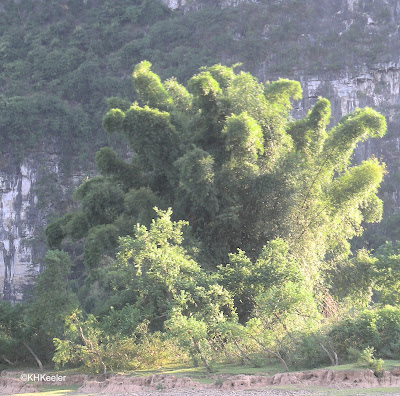 |
| wild bamboo, along the Li River in southern China (the plant that looks like an explosion) |
But beyond appreciating it aesthetically, Asians use it.
As scaffolding, seen here in Shanghai
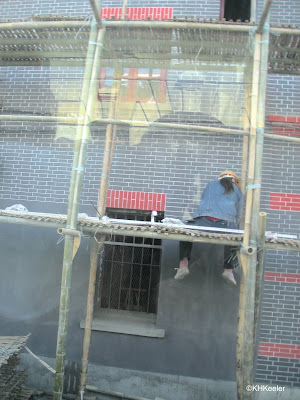 |
As fencing. Both the green wall and pale wall are bamboo stems (from Japan)
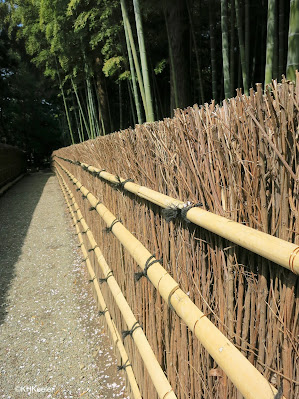 |
It makes cute, durable garden edging. This is one of many styles of bamboo I saw used in gardens, about one foot high, in Japan.
Bamboo stems are hollow, so it can be used as pipes. Below, from the pump. the pipes carrying the water are bamboo:
 |
| Bamboo faucet on bamboo water pipe, also in Bali, with red plastic handle |
Lots of experimental modern building is done with bamboo. I toured a house made entirely of bamboo. This was in Bali, where the bamboo grew locally, and they didn't need to insulate against the cold.
 |
| The pod with the swinging door is the bathroom |
Several different species of bamboo were used to build the house.
Bamboo furniture and flooring are common in the West as well as Asia.
 |
| bamboo chair and table, on a bamboo floor |
Bamboo leaves, branches, and sliced stems can be woven or plaited into useful items from hats to sandals to floor mats. Today the fibers are processed and woven into cloth for shirts, socks, sheets and more.
The rhizomes (underground stems) are hard and woody, and have been carved into useful things--tea bowls, spoons, brush holders, netsuk--for millennia. The Denver Art Museum has a spectacular collection of pieces carved of bamboo, such as the ones in the photo below. The first is an incense container, the second a box carved as two melons (the top lifts up).
Bamboo shoots are edible. In the U.S. we see them canned or floating in a Chinese dish. In China, bamboo shoots are an eagerly-awaited seasonal food. Bamboo seeds are edible and tasty, but plants don't flower regularly, so are not often available. Giant pandas, of course, eat bamboo and only bamboo. Lots of other animals eat some bamboo.
If you regularly harvest the bamboo growing in your yard, as building material or to eat, fast growth is a desireable trait, and the plant is not likely to invade other flower beds. Its not just an invader, it is a very useful plant.
Comments and corrections welcome.
References
Bess, N. M. 2001. Bamboo in Japan. Kodansha International, Tokyo.
Valder, P. 1999. The Garden Plants of China. Timber Press, Portland, Oregon.
Welch, P. B. 2008. Chinese Art. Tuttle Publishing, Tokyo.
Kathy Keeler, A Wandering Botanist
More at awanderingbotanist.com
Join me on Facebook: https://www.facebook.com/AWanderingBotanist

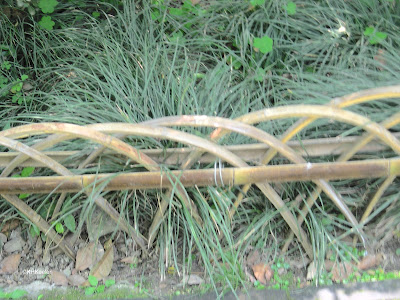





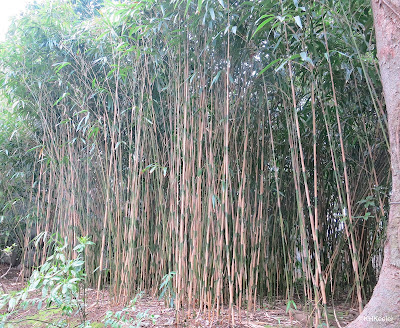
This comment has been removed by a blog administrator.
ReplyDeleteHey, I think your blog might be having browser compatibility issues. When I look at your website in Chrome, it looks fine but when opening in Internet Explorer, it has some overlapping. I just wanted to give you a quick heads up! Other then that, very good blog!
ReplyDeletebedding gq
It's so useful and bamboo is strong
ReplyDelete